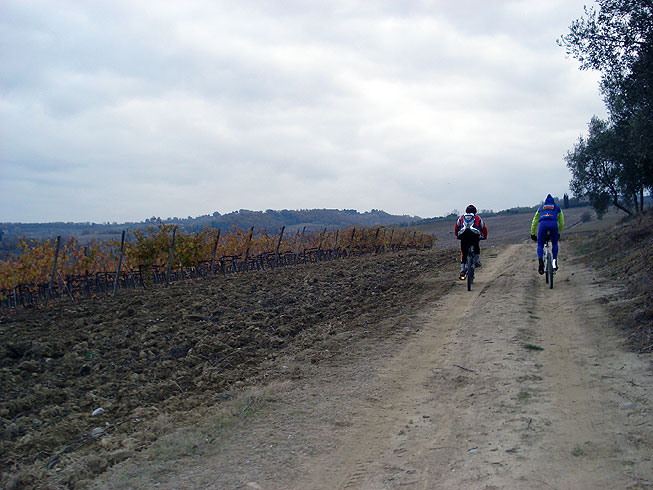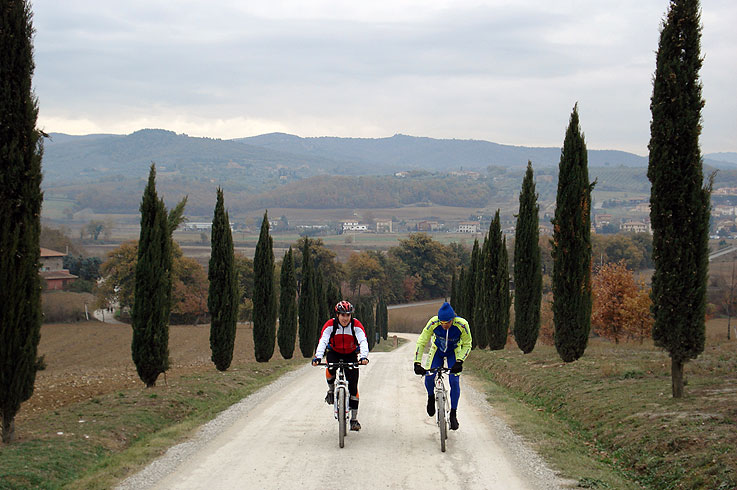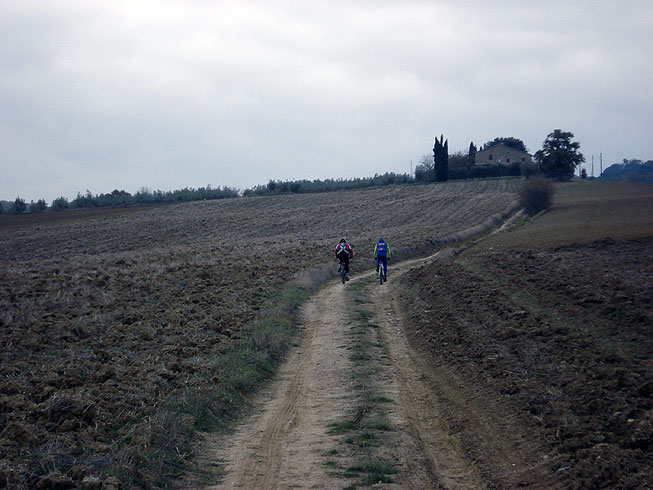| Starting point | Paciano |
| Finishing point | Paciano |
| Distance | 33 km |
| Total ascent | 850 meters |
| Grade | hard |
| Road surface | 70% dirt, 30% sealed |
| Recommended bike | MTB, E-MTB |
| Places to visit in the area | Paciano, Città della Pieve, Panicale, Monte Pausillo. |
It can be classified as medium-hard because of its height difference and its distance. The start is from the centre of Paciano in Piazza della Repubblica, where the trail descends downhill. Leaving the sealed road, it turns into a dirt road which goes under the railway and the main highway before returning to the sealed road below Villastrada.
It continues straight ahead up the short climb towards the “Le Coste” estate and after a quick descent, it meets the SS 71 at km 11,1 where it turns right towards Chiusi. The trail soon leaves the main road (km 11,4) and turns left up the first climb of the route: a wonderful dirt road first through the woods, then through fields and grapevines to San Litardo, where it picks up the SS 71 Nord and continues its climb towards Città della Pieve.
At Città della Pieve, a town of etrusco-roman origins, it is worth stopping at km 18,5 for a visit to the historical centre. From here the trail goes towards the sports ground and continues along a rather uneven dirt road after the sealing ends. At the bottom of the descent, it goes along a narrow valley until it crosses over the SP309 (km 24), into the dirt road on the other side and begins the second, hardest climb of the route.
The first 200 metres are very steep and rocky and may cause bikers to dismount, but the rest is not as rough. It continues through the woods for several kilometres, but towards the summit, the forest opens out onto breath-taking views that can reach as far as Mt. Abetone on clear days. The climb ends just a few metres from the top of Mt. Pausillo (km 29,5) where the trail start descending towards Paciano, a technical stretch to be covered with particular attention.
After the first few meters, turn right and climb briefly, take the narrow single track on the left inside the pine forest. Just outside the pine forest, turn left and resume the main dirt road that in a few kilometers takes you back to the center of Paciano.
Along the way, enjoy the regenerating power of the woods of Mount Pausillo, taking advantage of the wonderful views that open up on Lake Trasimeno and all the surrounding valleys, with a view that reaches up to Mount Amiata and that, on clear days, also embraces the Abetone. The villages crossed by the itinerary are also worth a visit. The historical center of Paciano, for example, is among the most beautiful villages in Italy for the remarkable environmental and artistic heritage, is enclosed in a fourteenth-century walls with towers and three gates and stands in an area rich in forests of oak and chestnut trees. The medieval village of Panicale is instead lying on the hills of Lake Trasimeno where you can enjoy beautiful views of the lake landscape and the valley of Nestore. Inside the country worthy of note are the Palazzo del Popolo, the Collegiate Church of San Michele, the complex of San Sebastiano and the Cesare Caporali Theater. Not to be missed is Città della Pieve: ancient Etruscan-Roman center, it has kept intact most of its ancient structure. Between the buildings of greater merit there are the Dome, that preserve the works of two great painters, the Perugino and the Pomarancio; the church of Saint Maria of the Whites, where the extraordinary Adoration of the Magi of the Perugino is found; the Fortress (1326), with five towers; the palace of the Corgna (XVI century); Bandini palace (XVI century); palace of the Fargna (XVIII century), center of the Common one, and Baglioni palace, of the XVIII century.





























